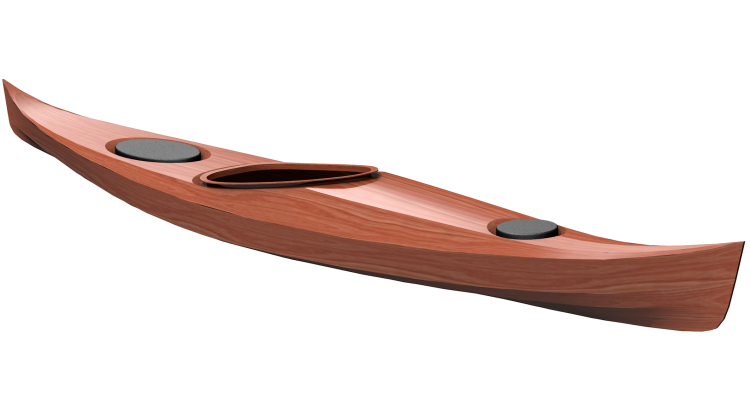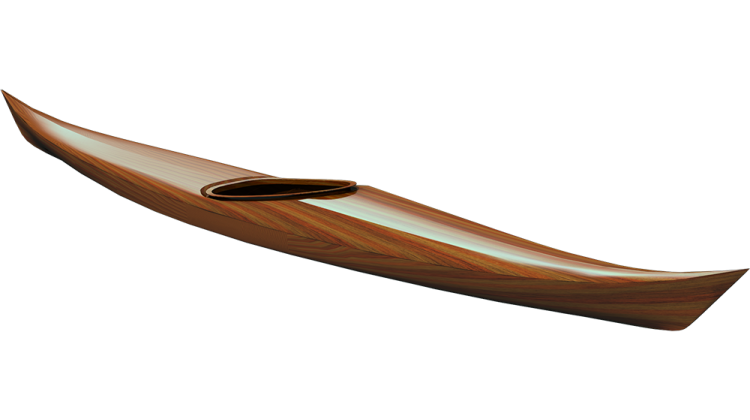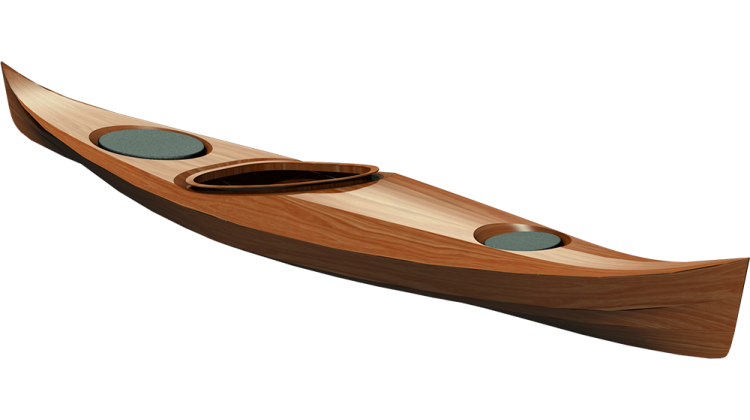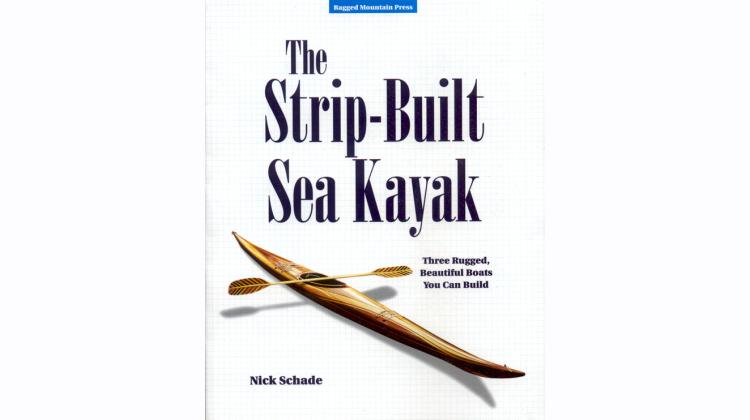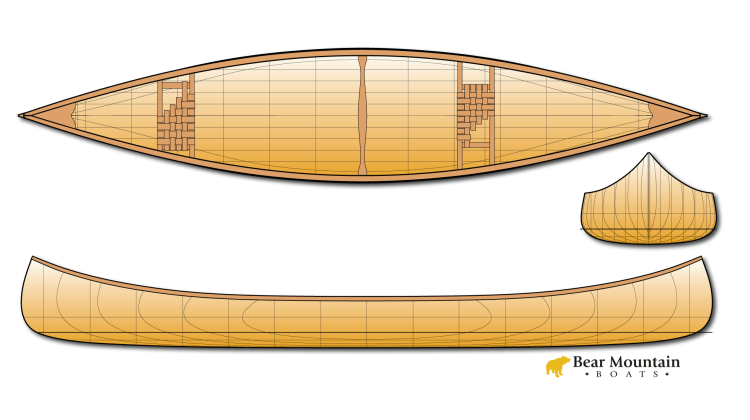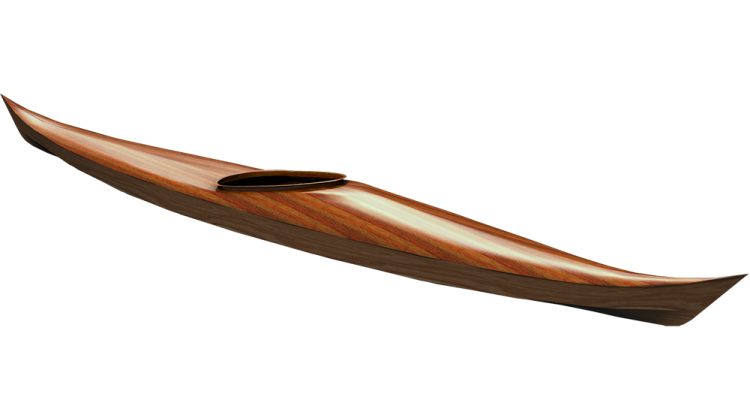Nick starts the video excitedly sharing his upcoming plans for a kayak retreat in Winter Harbor, Maine. He'll be taking a group of people kayaking around the islands in Frenchman Bay, showcasing the capabilities of his handcrafted wooden kayaks. Shifting gears, he moves to his workshop, where he's preparing to stain parts for a client's kayak. He meticulously cleans up the coaming recess pieces, explaining his attention to detail in sanding to avoid highlighting scratches in the wood.
Nick delves into his reasons for staining, emphasizing that it's based on the client's preference after seeing a similar finished boat. He highlights that staining enhances the wood's color and adds visual interest, especially for plywood boats. He stresses the importance of using an alcohol-based stain, specifically Behlen Solar-Lux, to ensure compatibility with the epoxy used in later stages of the kayak building process, unlike oil-based stains that can interfere with bonding.
The selection of the stain color becomes a thoughtful process. Nick considers the color of the kayak's body, accentuating feature lines, and the contrast between the Western Red Cedar and Okoume plywood used for the coaming recess. He tests various shades of mahogany, cherry, and even Van Dyck Brown on samples, observing how the color changes under different conditions, from dry to wet and with epoxy coatings. Nick demonstrates his meticulous approach, carefully considering how the stain interacts with the wood grain and how the final color will appear once the boat is finished.
Ultimately, Nick decides on Light Red Mahogany for both the cedar strips and the Okoume recess. He believes this will satisfy the client's desired aesthetic, offer subtle contrast between the recess and the boat's body, and showcase the natural beauty of the wood grain. He then applies the stain, noting its quick drying time and the importance of even application. He emphasizes that this stain should be applied as the final step before epoxy and demonstrates sealing the stained parts with a thin coat of epoxy for protection.
Looking ahead, Nick outlines his next steps: assembling the coaming recess, potentially adding an accent around the coaming lip, and cutting the hole in the kayak deck. He invites viewers to ask questions in the comments, encourages likes and subscriptions, and expresses his commitment to posting new content regularly.
Outline
- 0:00 - Kayak Retreat Plans
- 1:05 - Coaming Recess Staining Prep
- 3:30 - Rationale for Staining
- 5:00 - Stain Selection
- 8:05 - Stain Color Selection Process
- 4:35 - Final Color Choice and Stain Application
- 17:15 - Sealing Stain with Epoxy
So, 3:30 in the afternoon, and I'm just now getting into the shop. I've spent all day preparing for something I'm really excited about: my Schoodic sea kayak retreat with my friend, Gerry. We're going to be going up to Winter Harbor, Maine, in September to Schoodic Point, which is part of Acadia National Park. There's a great facility up there, the Schoodic Institute, which is right out at the end of Schoodic Point, where we're going to stay there and do kayaking around the islands in Frenchman Bay and around Schoodic Point, and I think it's going to be a lot of fun. I'm going to take a bunch of my wooden kayaks up there, let people try them out—try them and the conditions they're really designed for—and give people a chance to see what a lightweight, rugged sea kayak made out of wood really does out in those conditions. I think it's going to be a lot of fun. So, if you're interested in that, I've got another video—it just posted earlier today. But today, I want to do a little bit with the staining of those parts that I cut out yesterday, the coaming recess parts. So, I'm going to do a quick discussion about the stain and see if I can get a little bit of stain on those parts and make those ready for the next step, which will be assembling the recess and maybe a little bit of fiberglassing. I'm still trying to figure out things like accent strips, where they ain't going to install those on the recess, etc. But, for now, let's just take a little bit of a look at the stain.
These are the parts I cut out yesterday that constitute the coaming recess. Like I said, here's the sill, and this will be the part that brings the recess down, wraps around like that. This same idea wraps around from the backside like so. But the first thing I want to do is just sort of clean up some of the edges. The router bit didn't cut all the way through, and so I've got some little hairy edges down here where there's a little bit of excess fuzz. And so, I'm just going to take and turn that flash off of there, and some of the tabs that were holding the material through the rest of the plywood—doesn't need to be cleaned up perfectly. It's all going to get a major sanding at some point farther along in the process. We want to get rid of some of the hairy edges, so I've just got some sandpaper on various blocks here to clean this up. On this, I did make a little tab right here on the end. This marks the center in the back of the coaming or the recess, and I don't want to remove that because that will help me line up this piece which has a little notch in that same location. So, when it comes time to put these together, I can just line those up and make sure everything lines up well. I did make an effort when I was cutting these out to cut them out in the same piece of plywood in the same general orientation that they're going to be in in the finished boat. So, the grain pattern here runs across from one piece to the next as this wraps around. That falls down a little bit, but at least as close as it can be. When I'm sanding the face here, I'm sanding with the grain, and this is pretty fine sandpaper—212 or 220—because I don't want to create cross-grain scratches in this wood, because the stain is going to highlight any of that. When I'm sanding the face of this, I'm using a coarser grit, and I'm not hitting the corner here. I'm not trying to round this corner off. I want to make the surface nice and flat, and I'm not trying to change the shape any other than just getting rid of any of the CNC tabs that might be remaining. And usually between this sort of vertical sanding of the edge and this horizontal sanding of the edge, you can get rid of most of that roughness, and it'll look pretty good. So, once that's all cleaned up, I'm going to want to stain everything.
The reason I'm staining this is because the client saw one of my other boats, and he liked the looks of it. He liked the color of it and thought that looked pretty cool, and so he wants something that has a similar look to what he saw on my website. That's my intention, to give the client what he wants. But there's a few advantages to staining the wood. It can be really hard to find high-quality Western Red Cedar now with good color, so putting some stain on it is one way to enhance that color. You know, so, it takes a boring piece of wood and makes it much more interesting. I've done that a lot with Okoume plywood, stitch and glue boats, and I think it's a great way to take something that's might be a little bit drab or boring and punch it up a bit.
And so, the stain is an excellent way to do that. You can't use just any stain. Your typical oil-based furniture stain, like a Minwax or something like that, can interfere with the epoxy bond when you go to do the fiberglass. That oil is in between the wood and your epoxy and can—that can weaken the bond. And, actually, there can be chemical interactions between the epoxy and that oil if things aren't going quite right. We want to avoid that, so I use an alcohol-based stain. This material I've found works really well is this Behlen product. It's their Behlen Solar-Lux stain.You can get this in a variety of outlets. Just speak like CLC who sells kits for my designs, as this, and the variety of colors works really well. The Solar-Lux refers to the fact that it doesn't fade quickly in the sun. There's some really nice-looking stains that are excellent stains but are really meant for indoor furniture where, if they're in the sun, they're not colorfast, and the stain will fade away very quickly. And so, this is intended to be out in the sun or useful for being out in the sun. It's not to say that this stain will not fade. I've had some boats where I stored them on the roof of my car for years at a time, and, you know, after 8 years, the stain was pretty sad-looking. But this stuff does work, and I've been really happy with it. I've got it on boats that are, you know, 15-20 years old now, and they still look great. Decision right now is to figure out what color to go with, and I need to figure out a couple of different things with that: the color of the body of the boat, the, you know, the client's had—you know—saw a picture that he liked, and, you know, so, my first inclination is to just go with the color that's going to match what he saw on that web page, and that was in one of these medium red mahogany sort of colors, something like that. I—I tend to like those colors. Something about the red, I just find I like. It's, you know, it's—this is all personal preference, so what you like and what I like may be different, but he seemed to like a boat that had something along those lines.
What the question becomes, you know, if I go with that—and there's a variety of, sort of, the mahoganies here that are going to look good—there's a medium red mahogany, light red mahogany, this is cordovan mahogany.There's also blood red and some other things that have a little bit of a reddish hue to them. Since I'm putting the Okoume in the—the cockpit recess area, it's an opportunity to add a little bit of contrast. You know, I've got the accent stripes running down the centerline and different places on feature lines. And so, those subtle little accents can really give the whole look of the boat a little bit more depth. And so, similarly, while I'm having a different wood here with the Okoume, maybe I might want to stain that a little bit differently. You know, putting all the same color stain on everything will tend to blend it together, even though I've got Western Red Cedar here which is substantially darker than the natural color of this Okoume. I put some stain on it, and they're going to tend to merge together a little bit. The lightest color will still be lighter, the darker material will still be darker, but they're going to tend to look fairly similar. And maybe that's good, maybe that's bad. You know, I—I haven't decided right now. I'm still thinking about it, and part of my thinking about it will happen right here. So, this is just some samples of the material used on the boat, so I have those. I have some samples of the Okoume here, which I can use and spread some stain on, and then just, you know, look at them side by side, think: "Is that the look I'm going for?" One thing to keep in mind, you see with these samples here, I have my samples on some stuff that was naturally a little bit darker than the Okoume right here. You see the natural color, but not completely different. But then this, right at this line, I've got one coat of epoxy on it right in here. I've got just fiberglass. So, on top of the epoxy, I've got fiberglass with a coat of epoxy on it, and then I have put a fill coat on top of that. We've—so, you can see it changes its characteristics depending on what's on top of it. So, so, the richest is where you've got the most material on top of it, and where it's dry, it tends to not be as saturated in color. You know, the difference between here and here is just a coat of epoxy where this looks a whole lot darker than that does. So, if it's a little bit hard to envision what the finished boat is going to look like based just on the color you see in your samples, I tend to want to look at the samples when they're first wet because that's going to be the closest to this wet out. And you see the difference between this and—and this up here is substantially less than the difference between this and that. That's just the presence of one seal coat of epoxy on top of that stain. If we're looking at something like the—the medium red mahogany or potentially the cordovan mahogany here, the medium red tends to be a little bit darker, and there's a little bit of a purple hue to the cordovan mahogany. It looks a little bit less natural than the medium red or the light red. You know, I'm thinking with the dark colors we have here that, for the cedar, that it's not going to really need to go for the full dark, you know. I've got some nice grain, and here in the darker stain I put on here, the less that grain is going to show. So, going with something a little lighter to give it a bit of a hue that's different from its natural hue but still get more of that natural variation in color due to the grain, I think, might work well. Like, using this material here, so the light red mahogany. So, that's what we have in this bottle here. I've got things like cherry here. I was thinking it was possible that, like, doing the body of the boat in a medium red mahogany and then the Okoume in cherry might look pretty good. Might just give it some contrast there. So, I'm just going to wet out some samples with stain and take a look at them, see what I think. But I've got some medium red mahogany here, here's my light red mahogany—this is really hard to read—cordovan mahogany, the blood-red, I believe, Jerry, Van Dyke Brown. So, I'm going to put some of these colors on the cedar to see what it looks like on there, and other colors on the Okoume to see what it looks like on there, and then I can bring those two next to each other and see how they look going together. Got a box of gloves. This stain is very good stain. You get it on your hands, it won't come off until your skin falls off. I also have some what they're calling rags here, you know, paper cloth white rags. These are paper towels, but they're somewhat decent. I wouldn't stain the whole boat with this material, but for just doing this, these samples, it's not such a bad way to go. And a pencil so I can say, "Okay, this is the light red." All right, so, that's what the light red mahogany will look like. This is cordovan.
Maybe I should put some of this on here as well. The Behlen stains, you can make them darker with extra coats.Once one coat dries, put another coat on, and you'll get a deeper color. The easiest thing to do would be to do the Okoume and the cedar the same color, but I just want to explore my options and see if doing them in different colors might look cool. So, this is a cordovan. A slight red, light red, medium red, medium red. And this cordovan—with cordovan, I'm also thinking that, like, a cherry with one of those might look good. So, keeping this a lighter color—keeping the Okoume a lighter color than the cedar—might look sharp. In this light, the color of these looks all very much the same. You know, just put some of this on here. And, she—and then this Van Dyke Brown, I think, is a darker brown. This would be having the Okoume maybe lighter in color. The other option is to go with the—the Okoume being darker in color, get the contrast that way. I do have a jet black from this Behlen Solar-Lux that could look really sharp to having the coaming be in a jet black. I think, to my eye, that so can be a little bit much.
So, again, these colors, as they dry, they all start to look a little bit lighter. And noticing in the video screen there, they look a little bit darker than they appear in real life. So, light red mahogany, cherry, cordovan, and medium red mahogany. So, that's everything side by side, is the same color. In this light, the cordovan looks very purple and looks, frankly, weird. You take that, and you put a little bit of epoxy over it and fiberglass, and that mutes that purple, sort of fades a bit. But I—I'm thinking that looks a little bit too weird for me, so I'm going to put that on the side.This light red mahogany, I think, that looks pretty sharp on the cedar. It does less to hide the actual grain. I'm wondering if that next to something else would be good or if I'm just better off going with light red on the Okoume, too. I think they may be happiest with something like that.
You know, the other option is to go for a real contrast and not put any stain at all on the Okoume, and so the whole thing's quite bright. And I'm not really happy with that idea. I think having some stain on it gives it a little bit more color. The Okoume, over time, yellows a little bit, and so having a color over it, I think, gives it a little bit better long-term look to it. So, you know, do I go with something that adds a little bit of color but not a whole lot, like this cherry, or something that's going to be in the same tonal family as the rest of the boat with the light red mahogany overall? I think that's sort of where I'm leaning right now, something like that. So, that's—that's my thoughts on that. I think my sense right now is light red mahogany on the strips, light red mahogany on the Okoume.
I think that'll look sharp. And again, the color of this versus what it ends up with once it's got some epoxy on it—it's redder in this than it is in this sample, but, again, everything deepens substantially with the epoxy and fiberglass on it. So, I'm thinking that could look quite nice. So, being the color family that the customer saw, I think we'll get some contrast between the recess area and the body of the boat, which will look sharp. And so, that's what I'm going with. So, I'll finish up the cleanup of these parts. All right. Now I'm ready to put some stain on these. I think these pieces are small enough that I can use these white rags with this alcohol-based stain. It dries very, very quickly.
So, you want to put it on really wet, and you will not have the opportunity to wipe it off that you have with standard oil-based stains. So, oil-based stains you wipe on, let it sit for a little while, and then wipe it off. **Here, we're just going to put it on and try and put it on fairly wet, and that'll be—**here I'm going to stain both sides while I'm at it. One will be on the inside—nobody will ever see it. All right. So, one piece down. See, this rag is getting all chewed out really quickly, so I don't recommend these for not sustain. I have, you know, t-shirts and so forth that do a better job. But for this, this is good enough.
So, I often get the question with this stain, "Can I apply the stain to the strips before stripping up the boat?" And the answer is no. The stain is on very, very thin. It, you know, it soaks into the grain, but still, you know, if I were to sand one of these pieces, I'd be through the stain almost immediately even with very fine sandpaper. So, basically, I add the stain as the last thing before applying epoxy. But I feel a lot to do with the coaming recess between now and the time I'm ready to apply epoxy. So, I'm going to seal the stain under a thin coat of epoxy, just roll some on those parts, so as I work on them later on, I don't immediately damage that stain. I might have to touch things up here and there, but this way it will be under the protective coating of epoxy, and that should make sure I don't mess up the epoxy right away. So, I've mixed this epoxy up like normal. I'm not going to go into how them deal with epoxy right now. That is a big subject in this—one I will talk about and do, of course. So, I've got a little roller tray here, a little hot dog roller. Just going to roll on a coat of epoxy here, and you'll see the hot dog roller picks up a little stain. The stain is still very fresh. As the stain has a chance to set, it will become well-bonded to the material and so it won't bleed with the coating of more epoxy. But, at this point, it's still very, very fresh. It's picked up by the roller pretty easily. So, I'm not putting on a thick belt here. It's pretty thin. It's enough to sort of protect that layer of stain, make it so it won't be quite so delicate. One advantage of doing the epoxy coating is, still, a little bit runny is it will even out the coating of stain. So, if this sort of light and dark spots, it will tend to even those out and unify it a little bit. This is already looking better.
So, the next episode, I'm going to put the coaming recess together. I talked a little bit about maybe putting an accent around the coaming lip itself. I will think about that some more, and maybe I'll do that. I will start cutting the hole in the deck, I think I can probably handle that next episode, and we'll just see how far we get. I'm never quite certain. It depends on what interruptions I have. Once again, if you have any questions, please post them in the comments. If you liked this video and enjoyed and learned something, please give me a thumbs up. If you are enjoying this whole series and finding it interesting, hit subscribe, turn on notifications, whatever it takes so you're notified about each new episode. I'm trying to post something new every day during the weekdays. I'm sure I'll miss some, but, at this point, I've been holding—doing that pretty well. What time I post varies, because I'm often in the shop when I think is probably the best time to post it. I try and post it around lunchtime, around noon, but sometimes it's later, sometimes it's earlier. So, until the next episode, thanks for watching, and happy paddling!

